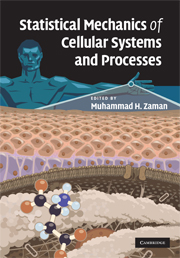Book contents
- Frontmatter
- Contents
- List of contributors
- Preface
- 1 Concentration and crowding effects on protein stability from a coarse-grained model
- 2 Observations on the mechanics of a molecular bond under force
- 3 Statistical thermodynamics of cell–matrix interactions
- 4 Potential landscape theory of cellular networks
- 5 Modeling gene regulatory networks for cell fate specification
- 6 Structural and dynamical properties of cellular and regulatory networks
- 7 Statistical mechanics of the immune response to vaccines
- Index
- Plate section
2 - Observations on the mechanics of a molecular bond under force
Published online by Cambridge University Press: 04 September 2009
- Frontmatter
- Contents
- List of contributors
- Preface
- 1 Concentration and crowding effects on protein stability from a coarse-grained model
- 2 Observations on the mechanics of a molecular bond under force
- 3 Statistical thermodynamics of cell–matrix interactions
- 4 Potential landscape theory of cellular networks
- 5 Modeling gene regulatory networks for cell fate specification
- 6 Structural and dynamical properties of cellular and regulatory networks
- 7 Statistical mechanics of the immune response to vaccines
- Index
- Plate section
Summary
Introduction
In the sections that follow, two issues focusing on the mechanics of a molecular bond under the action of an applied force are addressed. This discussion is motivated by the behavior of the noncovalent molecular bonds that account for adhesion of eukaryotic animal cells to extracellular matrix or to other cells, particularly bonding of transmembrane integrins to their ligands. The integrins are large, compliant molecules and the results of experiments on their behavior are reported in the literature. The discussion itself, however, is generic within the context of physical chemistry.
The first issue considered is the transient response of a single molecular bond to an applied force. The configuration of the system is represented by one or more stochastic variables and by a deterministic variable, the latter accounting for the force input. Bonding is understood to be the confinement of the configuration of the bond within an energy well, as represented by the stochastic variables, which exists as a feature of an overall energy landscape, and the role of the force is to distort that landscape. The system functions in a thermal environment, but the time required for bond separation is long compared to the thermal relaxation time of a single step in the Brownian motion of a small particle in that environment. The bond state is characterized by a probability distribution of possible configurations over the bond energy landscape, and the evolution of that distribution is governed by the Smoluchowski partial differential equation.
- Type
- Chapter
- Information
- Statistical Mechanics of Cellular Systems and Processes , pp. 26 - 53Publisher: Cambridge University PressPrint publication year: 2009



